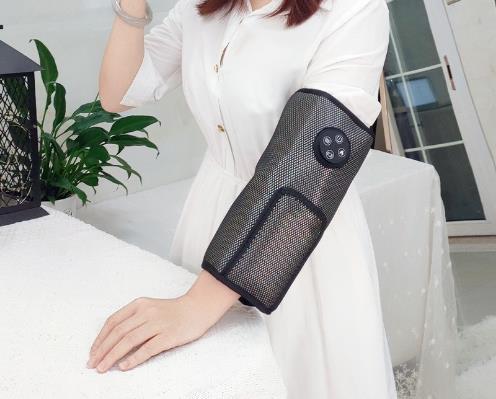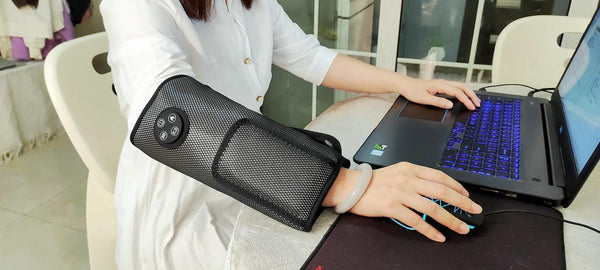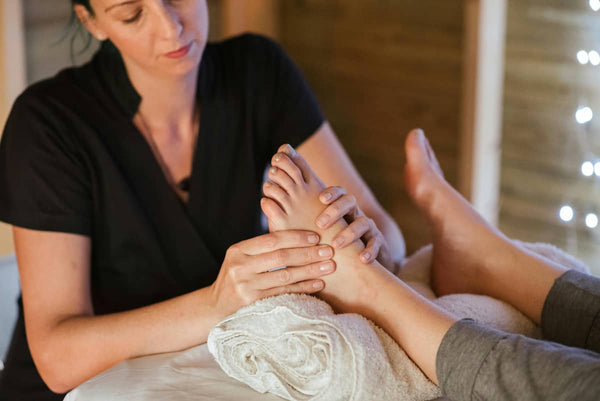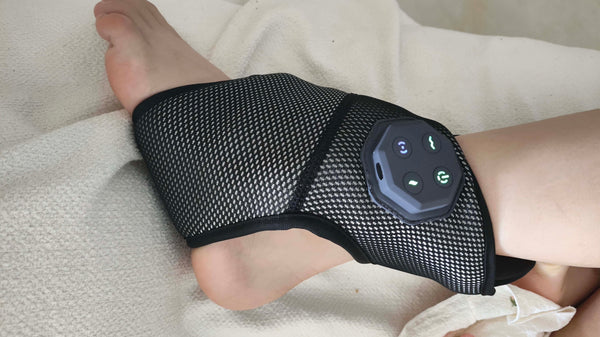 If you're an office worker, you know the feeling: a persistent ache in your neck, shoulders that feel like concrete, and a lower back that groans with every move. For many middle-aged and elderly individuals, this isn't a temporary problem but a daily reality. The promise of a deep tissue massage sounds like heaven, but weekly professional sessions can be costly and time-consuming. This leaves many wondering, is there a way to safely and effectively imitate that deep, therapeutic relief at home? The market is flooded with devices, but can a home massager electric truly stand in for skilled human hands? Many hope a good electric massager is the answer.
If you're an office worker, you know the feeling: a persistent ache in your neck, shoulders that feel like concrete, and a lower back that groans with every move. For many middle-aged and elderly individuals, this isn't a temporary problem but a daily reality. The promise of a deep tissue massage sounds like heaven, but weekly professional sessions can be costly and time-consuming. This leaves many wondering, is there a way to safely and effectively imitate that deep, therapeutic relief at home? The market is flooded with devices, but can a home massager electric truly stand in for skilled human hands? Many hope a good electric massager is the answer.
The answer is a nuanced 'yes'. With the right tools and, more importantly, the right knowledge, you can significantly alleviate chronic muscle tension yourself. However, this path is not without its pitfalls. The central debate isn't just about whether an massager electric works, but whether it can replace professional care and how to use it without causing harm. This guide will serve as your rational "pitfall avoidance" manual, helping you navigate the options and techniques for effective at-home care with your chosen massager electric.
What is Deep Tissue Massage, Really?
Before we can imitate it, we must understand what deep tissue massage truly is. It's a common misconception that "deep" simply means "hard pressure." In reality, it’s a specific therapeutic technique focused on reaching the deeper layers of muscle and fascia. The goal is to release chronic tension using slow strokes and targeted pressure. These "knots" you feel, known as adhesions, are bands of painful, rigid tissue that can cause pain and limit movement. A good deep tissue massager aims to replicate this process to provide relief best for muscle pain.
For office workers and older adults, these adhesions often form from predictable causes like poor posture or a sedentary lifestyle. Over time, these minor stresses accumulate into chronic pain that an massager electric can help manage. A proper deep tissue massage breaks down these adhesions to restore normal movement. This is precisely what people hope a home deep tissue massager can achieve. Understanding this goal is the first step in choosing a good electric massager.
The Rise of the Home massager electric: How Do They Work?
This is where technology steps in, offering promising solutions. The most popular tools for mimicking deep tissue effects fall into two main categories. First are the percussion massagers, often called massage guns. These devices use a powerful motor to deliver rapid, repetitive pulses deep into the muscle tissue. This percussive therapy from a quality massager electric aims to increase blood flow and release tension with a force that’s difficult to replicate manually. They are particularly effective for large muscle groups and are a popular type of massager electric.
The second category includes shiatsu-style or kneading massagers. While "KLCOSY" represents a brand, the technology involves rotating nodes designed to mimic a therapist's thumbs. A good electric massager in this category provides a circular, kneading pressure that is excellent for relieving general stiffness. Many users find this type of massager electric more relaxing. Both types of a deep tissue massager work to disrupt the pain cycle, and learning how to use electric massager of either type is key to finding relief that's best for muscle pain.
Beyond Gadgets: Essential Techniques to Enhance Your Relief
A powerful massager electric is only one part of the equation. To truly get the most out of your at-home sessions and supplement the work of your device, integrating specific stretching techniques is a game-changer. One of the most effective techniques is Proprioceptive Neuromuscular Facilitation (PNF) stretching, a "tense-relax" method. You gently push the muscle against resistance, then relax into a deeper stretch. This is a great complement to using an massager electric for muscle relief.
Partner-assisted stretching is another fantastic supplement after using your deep tissue massager. Having a partner provide gentle, steady pressure can help you relax into a stretch more deeply. This combination is often best for muscle pain that's hard to reach. Here are some ways to combine these techniques:
- Pre-Massage Warm-up: Use a light, kneading massager electric on a low setting for 5 minutes to warm up the muscle tissue before stretching.
- PNF for Hamstrings: Lie on your back and have a partner gently lift one leg. Push against their hand for 5-6 seconds, then relax and let them guide your leg into a deeper stretch for 20-30 seconds. Repeat 2-3 times.
- Post-Massage Cool-down: After using a deep tissue massager, perform gentle static stretches on the areas you worked to improve flexibility. This is a crucial step in how to use electric massager effectively.
How to Use Electric Massager Safely: The Do's and Don'ts
 Herein lies the most critical advice. Improper use of a powerful massage tool can turn a solution into a problem. And let's be honest, the temptation to just "blast away" a knot with maximum pressure is real. To be a "pitfall avoidance" guide, I must emphasize that more is not always better. Your body's feedback is your most important guide when using any massager electric. Listen to it carefully.
Herein lies the most critical advice. Improper use of a powerful massage tool can turn a solution into a problem. And let's be honest, the temptation to just "blast away" a knot with maximum pressure is real. To be a "pitfall avoidance" guide, I must emphasize that more is not always better. Your body's feedback is your most important guide when using any massager electric. Listen to it carefully.
A good electric massager comes with responsibility. Think of it as a power tool for your body—it requires respect and proper handling. The goal is to feel therapeutic release, not sharp pain. If you feel bad pain, stop immediately. Adhering to a few simple rules about how to use electric massager devices will ensure you get the benefits without the risks, making your device a sustainable part of your wellness routine for managing what's best for muscle pain and stiffness. An massager electric should be a tool for healing, not harm.
- DO Start Low and Slow: Always begin with the lowest intensity setting on your massager electric to see how your body responds.
- DO Keep it Moving: Don't hold the deep tissue massager in one spot for more than 15-30 seconds. Glide it slowly over the muscle belly.
- DO Stay on the Muscle: Avoid running the massager directly over bones, joints, the front of your neck, or your spine. Stick to soft tissue.
- DON'T Use on Acute Injuries: If you have a recent sprain or strain, do not use a massager electric on that area without a doctor's clearance.
- DON'T Push Through Sharp Pain: Therapeutic discomfort from a good electric massager is one thing; causing genuine pain is another.
- DON'T Overdo It: Limit sessions to 10-15 minutes per large muscle group to avoid over-stimulation from your massager electric.
When to Skip the DIY and See a Professional
While home massage tools are excellent for maintenance, they are not a substitute for professional medical diagnosis. A licensed therapist is trained to identify the root cause of your pain. A machine, even a very good electric massager, cannot feel your tissue respond and adjust its technique in real-time. It's a really, really important distinction to remember when relying on an massager electric for relief.
Knowing when to put the gadget down and pick up the phone to call a professional is a sign of wisdom. Think of your massager electric as part of your team, but not the head coach. You should seek professional help immediately if you experience any of the following red flags after using a deep tissue massager:
- Pain that is sharp, shooting, or electric in nature.
- Numbness, tingling, or weakness in your limbs.
- Pain that doesn't improve or gets worse after a few days of self-care with your massager electric.
- Pain resulting from a significant trauma, like a fall or car accident.
- Swelling, redness, and heat in the painful area.
Conclusion: A Powerful Tool, Not a Magic Bullet
So, can you truly imitate deep tissue massage at home? In many ways, yes. A high-quality massager electric can be an incredibly effective tool for managing chronic aches and pains. When combined with smart techniques, it can provide significant relief. Finding the device that's best for muscle pain specific to you is key. A good electric massager can become a cornerstone of your self-care routine.
However, these devices are supplements, not substitutes. They lack the diagnostic skill and intuitive touch of a trained therapist. By understanding how to use electric massager products safely, respecting their power, and knowing when to seek professional help, you can unlock the tremendous benefits of your deep tissue massager and make your massager electric a valuable ally in your health journey.
Frequently Asked Questions
What are the top recommended electric massagers for home use?
The "top" recommendation truly depends on your specific needs. For deep relief in large muscles, a percussion massager electric (massage gun) is often preferred. For relaxation in areas like the neck, a shiatsu-style kneading massager is typically a better fit. A good electric massager is one that matches your primary pain points, has adjustable intensity levels, and comes with suitable attachments. Ultimately, the best massager electric for you is one you'll use consistently and safely.
Are electric massagers safe for daily use?
For most healthy individuals, yes, using an massager electric for short periods (around 10-15 minutes per muscle group) can be safe for daily use. It's an excellent way to manage chronic stiffness. However, safety hinges on listening to your body. If you feel excessive soreness, take a day off. People with certain conditions should consult their doctor before using any deep tissue massager. Always follow the guidelines on how to use electric massager devices properly to ensure it's best for muscle pain relief, not a cause of it.
How does a massage machine compare to a professional massage?
A massage machine and a professional massage serve different purposes. An massager electric offers incredible convenience and cost-effectiveness for daily maintenance. It's available 24/7. A professional therapist, on the other hand, provides expert diagnosis and can identify the root cause of your pain. A good electric massager is a fantastic tool for self-care and symptom management, while a therapist is a healthcare provider for diagnosis and treatment of complex issues that no massager electric can solve alone.
This reply is generated based on currently verifiable public information. It is recommended to cross-check key content with authoritative sources. The information provided is for educational purposes only and does not constitute medical advice. Always consult with a qualified healthcare professional before beginning any new treatment or wellness routine.




0 comments